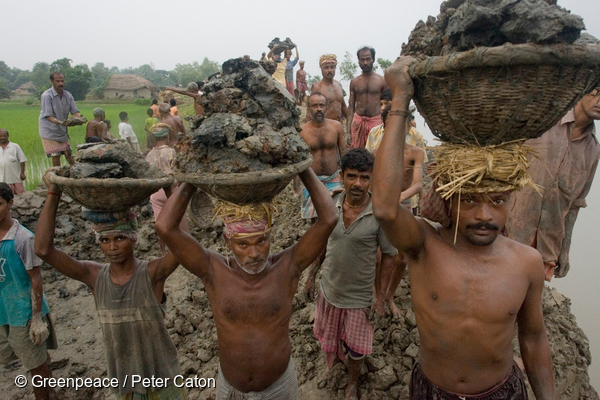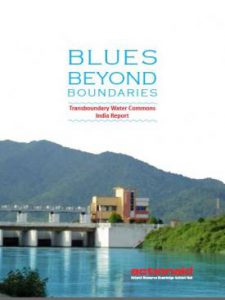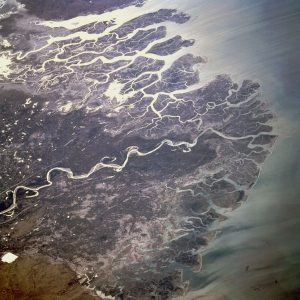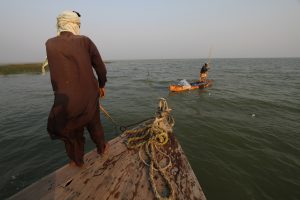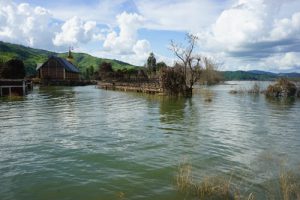Like the previous year, floodwaters again inundated Ronu Khatun’s homestead in Bangladesh’s Sirajganj area this monsoon, damaging the vegetables and fruits that help the family of six tide over financial crises. For the 45-year-old, the one hope now is a flood insurance scheme launched by Oxfam Bangladesh to help those like her fight natural disasters.
It’s an annual story of tragedy and the struggle to survive. Every year, arable land in Ronu’s Boro Chouhali village in Chouhali upazila (sub-district) goes under water and her family, like others in the area, must depend on selling vegetables from their garden to survive as they have no alternative income during the lean season.
“I was able to sell vegetables and fruits for about Tk 2,000 (US $25) per week from my homestead during the dry season. But the flood has damaged all the vegetables and fruits again this year, putting our lives in peril,” Ronu told thethirdpole.net.
She is banking on getting some compensation for the losses from the flood insurance scheme introduced by Oxfam Bangladesh in 2013. “The floodwaters have been flowing above the danger level at many points near our village. So we hope we will get money from the insurance,” she said.
Oxfam Bangladesh’s scheme, the first of its kind, has begun with a pilot project in Sirajganj, a flood-prone area of the trans-boundary Jamuna River. It is aimed at designing a commercially pragmatic catastrophic flood insurance scheme for the poor and vulnerable and encourage medium sized companies to invest as well. The organisation provides Tk 825 (US$10) as premium per household.
[googlemaps https://www.google.com/maps/embed?pb=!1m14!1m8!1m3!1d10337015.519594453!2d92.089033!3d23.693249!3m2!1i1024!2i768!4f13.1!3m3!1m2!1s0x39fdc1df830dba1b%3A0x58f0cbb092e78b62!2sSirajganj%2C+Bangladesh!5e1!3m2!1sen!2suk!4v1441877556023&w=480&h=225]
Rebuilding lives
With floods severely affecting the lives of people living in the flood-prone areas of Sirajganj district each year, the insurance payout helps them cope with the economic fallout due to lack of livelihood options. The villagers spend the money to repair their homes, invest in seeds or fertilisers to grow more crops and enhance yields.
Ronu Khatun, for instance, said the money helped her family buy seeds after the floods last year. This produced about 400 kg of pulses.
“We got Tk 2,800 (US$36) of payout from the insurance scheme last year. This was a blessing for us as we were facing a hard time after the floods,” added Selina Khatun of Fulhara village, also under Chouhali Upazila, another beneficiary of the insurance scheme.
She used the money to buy fertilisers and grow more crops. “We were able to minimise the losses caused by the floods to some extent. I hope we will get compensation this year as well with the floods once again impacting us,” Selina said.
Hundreds of other poor households are looking forward to getting the same back-up this year too.
In 2014, more than 700 families in four villages received Tk 20 lakh (US$25,000) to rebuild their lives.
“The local community is very positive about the flood insurance scheme. As they are benefiting from it, one day they will also pay premium willingly… though the donor agency is currently providing the premium of the insurance,” Amir Hossain, deputy director of local NGO Manab Mukti Sangstha (MMS), Oxfam’s local partner organisation said.
Project details
Covering 1,661 households, the flood insurance scheme is being piloted in 14 villages across four unions in Sirajganj Sadar and Chouhali Upzilas. The project is being implemented by MMS while Pragati Insurance Limited, a leading general insurance company of Bangladesh, is working as the insurer in the project.
Oxfam and the India-based Centre for Insurance and Risk Management (CIRM) had worked on a collaborative design and research study for developing the catastrophic flood insurance scheme in Bangladesh. The Institute of Water Modelling (IWM) prepared a flood hazard model to generate flood data with support from the Swiss Development Cooperation.
According to project officials, the IWM model predicts the floodwater level or depth instead of flood losses; the data generated is used to determine the premium for the insurance scheme. The model also acts as a tool to calculate compensation.
In the index-based scheme, premium and policy are prepared in accordance with the depth and duration of flood. If the duration of the flood is less than 10 days, people will not get any money.
Oxfam’s local partner MMS provides the flood data to IWM every day, said
Oxfam programme officer Mozahidul Islam. “After calculating flood data, if the IWM finds that the water level is above the danger level for at least 11 days in a row, the payout of the insurance scheme will be given to the households.”
If the flood continues for at least 11 days during June 23 to September 30, selected households get Tk 2,000 each as compensation under the insurance scheme. If the flood continues for 21 days, this is doubled to Tk 4,000 (US$50) for each household; for 26 continuous flood days, the compensation is further hiked to Tk 8,000 (US $100).
Scaling up the scheme
According to Mozahidul Islam, the insurance project has already brought positive results for vulnerable people.
“Oxfam has plans to expand the insurance scheme in other flood-prone districts like Gaibandha, Nilphamari, Kurigram and Lalmonirhat to help the flood victims increase their resilience to floods,” he said. The government, he added, could also introduce such schemes in flood-prone areas.
In Amir Hossain’s view, the government can run such an insurance scheme from the money it spends on relief works across the country during flooding if there is strong political commitment.
Floods are common in Bangladesh, causing huge losses to property and crops each year. About 80% of the plains in Bangladesh are inundated each year during monsoon. The Ganga, Brahmaputra and Meghna river basin is one of the most flood prone areas in the world.
Bangladesh has experienced eight devastating floods during 1977-2007, including in 1998 when 100,000 square kilometres (about 66% of the country’s area) was under water, killing more than 1,000 people and affecting 30 million, according to official figures.
